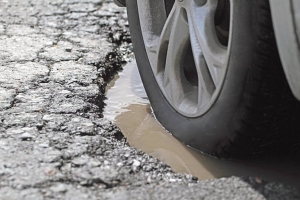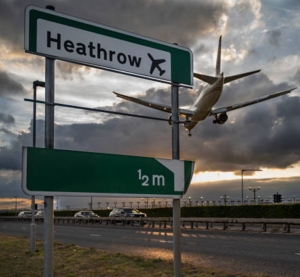Councils Face Funding Cuts Without Transparency on Pothole Repairs
English councils will soon be ranked on their pothole repair performance, with those failing to publish detailed progress reports at risk of losing millions in road funding. The Department for Transport (DfT) is offering a £500m boost to local authorities from mid-April, but 25% of this funding will be withheld unless councils submit annual updates on their road maintenance efforts.
Prime Minister Sir Keir Starmer confirmed a new red-amber-green (RAG) rating system will track how effectively councils are addressing potholes. He said the aim is to bring greater transparency and end the "postcode lottery" of road quality. The move comes as data from the RAC shows an average of six potholes per mile across England and Wales.
While the government insists the plan promotes accountability, local leaders and opposition parties have criticised it. The Local Government Association (LGA) said the funding falls far short of what’s needed, with one council reporting a £410m shortfall. Critics also argue the focus should be on long-term preventative maintenance, not quick fixes.
Transport Secretary Heidi Alexander defended the policy, saying most councils should meet the requirements. Authorities must report spending, pothole numbers, and future plans by June, and show community consultation by October - or risk losing a quarter of the promised funding.
DVSA Announces Major Changes to Vehicle Inspection Rules from April
The Driver and Vehicle Standards Agency (DVSA) has confirmed a range of updates to its inspection manuals, with new regulations coming into force from 1 April 2025. These changes will directly affect HGV drivers and public service vehicle (PSV) operators across the UK, with the aim of improving vehicle safety and inspection clarity.
Among the most significant changes are revised rules on side guards, now requiring certain tank vehicles carrying fluids to be fitted with compliant guards “so far as is practicable”. A new exemption list applies to vehicles first used from April 2025, including articulated tractor units, gulley emptiers, car transporters, and some category T vehicles. The manual also features new imagery for side guard inspections and guidance on blind spot radar devices installed in guard gaps.
Visibility standards have been updated to reflect the growing use of monitors and camera systems in place of traditional mirrors. The manual now outlines when and how these systems should be assessed, depending on their function.
Further changes affect fuel tank inspections, now expanded to include hydrogen fuel cells, with clear procedures for checking LPG, CNG, and LNG tanks. Brake pipe regulations have also been updated, setting a new threshold for wall thickness deterioration to help identify serious safety concerns.
Heathrow Shuts Down After Substation Fire Sparks Widespread Chaos
Heathrow Airport has closed all operations after a major fire at an electrical substation in Hayes, west London caused a significant power outage. The fire broke out just before midnight on Thursday, with emergency services called to Nestles Avenue at around 23:23. Though the blaze was brought under control by early Friday morning, the damage disrupted power supplies to Heathrow and surrounding areas, including the failure of the substation’s backup systems.
As a result, Heathrow confirmed it would remain closed until at least 23:59 on 21 March, with no clear timeline for full power restoration. More than 1,300 flights have been affected so far, according to Flightradar24, with many aircraft cancelled or diverted mid-air. Travellers have been urged not to go to the airport and instead contact their airlines for the latest updates.
Airlines including British Airways, Virgin Atlantic, and United have grounded multiple flights, while Qantas and Cathay Pacific have diverted some services to other European cities such as Paris. Amsterdam’s Schiphol Airport has also reported cancellations for flights to and from Heathrow. Gatwick Airport has said it stands ready to support where needed.
The power outage has affected over 16,000 homes across west London, with around 4,900 still without power, according to energy suppliers. Heathrow Express is running a reduced half-hourly service, and several roads near the substation remain closed. The airport has apologised for the disruption and provided a helpline on 020 8757 2700.
£250,000 Safety Upgrades Introduced at M1 Service Stations
New security measures worth £250,000 have been installed at Watford Gap and Northampton Services on the M1 to improve safety for drivers. The enhancements include advanced automatic number plate recognition (ANPR) systems, additional CCTV cameras, and upgraded fencing. Funded by Northamptonshire’s Police, Fire and Crime Commissioner (PFCC), the improvements aim to create a more secure environment and deter criminal activity at these busy service stations.
Roadchef, the company that owns both sites, welcomed the investment, stating that the upgrades would provide greater security for those stopping at the services. Watford Gap Services, which opened in 1959, has a rich history, once serving as a popular meeting place for musicians, including The Beatles and Jimi Hendrix. Meanwhile, Northampton Services, formerly known as Rothersthorpe, was initially planned as the UK’s first service station but did not open until 1979.
A Crimestoppers campaign has also been launched to raise awareness among drivers about vehicle security and how to prevent theft. Information will be shared through leaflets and display boards, encouraging motorists to take precautions against potential crime.
Northamptonshire’s Police, Fire and Crime Commissioner, Danielle Stone, highlighted the importance of these upgrades in making the service areas safer. She emphasised that deterring criminal behaviour would allow police officers to focus more on community engagement, ensuring they remain visible and accessible to the public. Roadchef’s Darrell Wade also praised the improvements, describing them as essential for enhancing driver safety and security.
Major Urban Logistics Development Begins in Leeds
Construction is now underway on a substantial 223,000 sq ft urban logistics scheme in Leeds, known as T45. The project will feature 23 industrial units ranging in size from 4,450 sq ft to 34,000 sq ft, available for both leasehold and freehold purchase. Once completed, the development is expected to have a gross value of approximately £46.5 million. Situated within the Cross Green industrial area, T45 benefits from a prime location on the A63 East Leeds link road, offering strong transport connections.
The scheme is being delivered by developer Chancerygate in partnership with Bridges Fund Management, a specialist in sustainable and impact investment. Spanning 11.1 acres, the project is set for completion in early 2026. Chancerygate’s development director, Chris Brown, described T45 as the largest multi-let urban logistics scheme of its kind in Leeds in a generation, and the company’s first new-build project in Yorkshire. He highlighted the development’s strong sustainability credentials and excellent connectivity, being less than a mile from the M1, predicting strong demand due to the lack of new industrial space in the city.
Chancerygate, established in 1995, has an extensive portfolio of logistics developments, with 1.16 million sq ft of space either under construction or in the pipeline across multiple locations, including Edinburgh and Croydon. Bridges Fund Management, meanwhile, focuses on investments that drive sustainability and inclusivity, supporting industries such as healthcare, affordable housing, and environmentally friendly logistics. The two firms have a long-standing partnership, having collaborated on various developments for over a decade.
With its strategic location and high sustainability standards, T45 is expected to attract strong interest from businesses within the Leeds City Region. The project is being marketed by joint agents JLL and Carter Towler, who are overseeing leasing and sales inquiries.
Volvo Trucks Leads Heavy Electric Truck Market for Fifth Year
For the fifth consecutive year, Volvo Trucks has maintained its position as the market leader in Europe’s heavy electric truck sector, holding a 47% share. In 2024, 1,970 Volvo electric trucks were registered across Europe, with Germany, the Netherlands, Sweden, Norway, and Switzerland emerging as the top markets. Volvo has also strengthened its presence in North America, securing over 40% of the heavy electric truck market in the region.
Volvo Trucks President Roger Alm expressed pride in the company’s role in driving the shift towards zero-emission transport. He highlighted Volvo’s expanding electric truck range, which caters to regional, urban, and construction transport. A new model capable of travelling up to 600 kilometres on a single charge is set to be introduced soon. Alm also extended gratitude to transport firms investing in sustainable solutions, as well as to Volvo’s dealers, suppliers, and employees who support the transition.
Since beginning serial production of electric trucks in 2019, Volvo Trucks has expanded its range to eight models, delivering over 4,800 units worldwide. The company’s electric fleet has now covered more than 140 million kilometres in real-world operations, significantly reducing emissions for customers in various regions.
However, with electric trucks making up just 1.3% of Europe’s total truck market, further action is needed. Alm stressed that widespread adoption depends on improving charging infrastructure, reducing operating costs, and implementing supportive policies. He emphasised the need for 40,000 fast chargers along European roads to accommodate a projected 400,000 electric trucks by 2030. Volvo is actively engaging with stakeholders to accelerate the transition to a sustainable transport future.
UK Set to Roll Out 54 New Electric HGV Charging Hubs
Innovate UK has announced the locations for a nationwide network of 54 electric HGV charging hubs to support the shift to zero-emission freight transport. These hubs are being developed through four key projects—Project Electric Freightway, eFREIGHT2030, ZENFreight, and HyHAUL - under the Zero Emission HGV and Infrastructure programme. The announcement follows the opening of the UK's fifth electric HGV charging hub in Immingham, the first UK site launched by Milence.
At the recent Zero Emission HGV and Infrastructure Demonstrations (ZEHID) summit in London, attended by over 400 businesses, Innovate UK outlined its £200 million investment plan. This will fund hundreds of zero-emission HGVs alongside essential charging and fuelling infrastructure. Simon Buckley, knowledge transfer manager for Zero Emission Mobility, said the hubs will tackle a key challenge—reliable charging. The hubs will be spread across the UK, including Scotland, Wales, and Northern Ireland, with most in England.
Moto, a major motorway service provider, plans to install up to 300 electric HGV charging bays at 23 locations by 2030. Construction on the first two superhubs, in Exeter and Tamworth, begins in April following planning approval. RHA senior policy lead Chris Ashley welcomed the long-awaited infrastructure plans, saying they will give operators confidence in moving away from diesel.
Industry leaders see this as progress but warn of remaining challenges. Wincanton CEO James Wroath noted that while infrastructure expansion is positive, cost barriers still hinder electric HGV adoption. Research shows only 25% of logistics firms expect alternative fuel vehicles to be affordable within six years. With over half struggling to meet net-zero targets, experts urge more government support, financial incentives, and faster infrastructure development.
Business Leaders Call for Logistics to Be Central to UK’s Industrial Strategy
The heads of 30 leading UK businesses have written to Business and Trade Secretary Jonathan Reynolds MP, urging the government to prioritise the logistics sector in its forthcoming Industrial Strategy. Spearheaded by business group Logistics UK, the signatories - including Amazon, Heathrow Airport, and Tesco - highlight the crucial role of supply chains in supporting all areas of the economy and call for logistics to be represented on the newly formed Industrial Strategy Council.
David Wells OBE, Chief Executive of Logistics UK, emphasised that logistics underpins the success of every industry, ensuring the smooth operation of hospitals, schools, factories, and retailers. He warned that failing to acknowledge the sector’s importance would hinder economic growth. The government’s Industrial Strategy Green Paper has introduced the concept of ‘foundational sectors’ - industries that provide essential support to others - and business leaders argue that logistics must be formally recognised as one of them.
The UK’s ranking in the World Bank’s Logistics Performance Index has dropped from 4th to 19th over the past decade, largely due to congestion, border delays, and inadequate transport infrastructure investment. Wells stressed that reversing this trend through targeted policies and investment could unlock up to £8 billion in annual productivity-led growth, as identified by Oxford Economics.
The business leaders are calling for logistics to have a dedicated voice on the Industrial Strategy Council to ensure the sector is fully integrated into the UK’s growth strategy. They argue that improving efficiency in goods movement is essential to boosting the economy, and that a partnership between government and business would help deliver long-term prosperity.
Lorry Driver Shortage Worsens as Industry Struggles to Attract New Recruits
The UK is once again facing a shortage of lorry drivers, raising concerns about potential supply chain disruptions and empty supermarket shelves. While the industry saw a temporary boost in recruitment following the Covid crisis - driven by wage increases and financial incentives - the number of HGV drivers has now dropped to around 266,000, more than 20,000 fewer than pre-pandemic levels.
A key factor behind the decline is the ageing workforce. According to training provider HGVT, over half of HGV drivers are aged between 50 and 65, while fewer than 2% are under 25. With a large portion of drivers expected to retire in the next decade, the lack of young recruits is set to worsen the shortfall. Meanwhile, rising minimum wages have narrowed the pay gap between lorry drivers and lower-skilled jobs, making the role less financially appealing. In 2011, HGV drivers earned 62% more than the minimum wage, but today that figure has dropped to just 38%.
Long and unpredictable hours remain a major deterrent, particularly for younger workers looking to maintain a work-life balance. Chris Kirk from Maritime Transport noted that new recruits are often put off by being away from home for extended periods, making it difficult to juggle family commitments.
Additionally, the increasing use of surveillance technology, such as in-cab cameras monitoring driver fatigue, has added to frustrations within the industry. Many drivers feel they are being excessively monitored, further discouraging people from entering or staying in the profession. With recruitment slowing and retirements increasing, the industry is bracing for further challenges in the years ahead.














